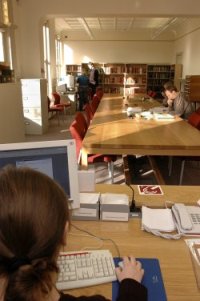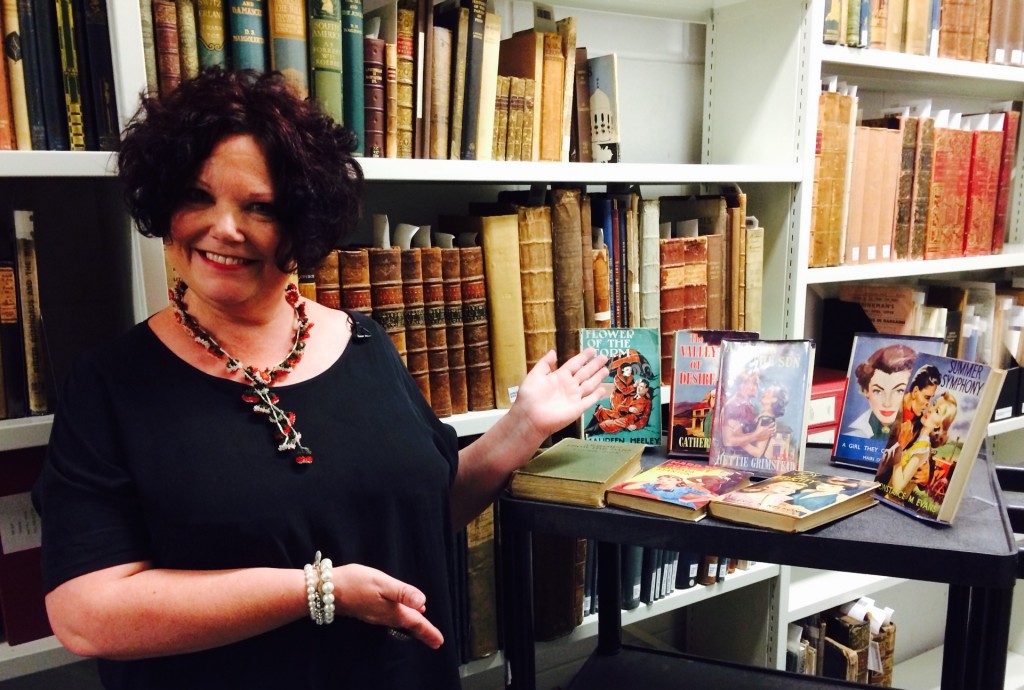As we look to recruit a new Graduate Trainee Library Assistant (closing date 25/08/2014) here is a quick introduction to the role and overview of my day to day activities…
Written by Claire Wooldridge, UMASCS Graduate Trainee Library Assistant

Book jacket exhibition I assisted with (Winter 2014)
The role of GT here at UMASCS has been exciting and varied, packed with interesting projects and valuable opportunities for new experiences and training. Below is a brief introductory overview of the requirements of this role.
My main tasks revolve around assisting the UMASCS library team and taking care of the day to day operations of the MERL and Special Collections libraries. Each day is different as I complete a variety of tasks; I rarely spend a whole day sat at my desk. There are certainly lots of tasks to keep on top of, but it is this variety that I have enjoyed most whilst working at Special Collections!
A place for everything…
Every day I make time to keep up with shelving, of books used by readers in the reading room, that have been returned to our closed access stores and of new books. During University term time I will fetch books from the store that have been selected by the librarian and academics in the University for use in teaching (and await the later need to shelve them again!). I will also assist readers and colleagues if they are having trouble finding books.
Reading Room

Our Reading Room
Here at UMASCS all members of the library and archive team contribute to the staffing of the reading room service. The reading room is mainly run by the archives graduate trainee (the Reading Room Assistant) and as the library trainee, I am likely to do 1-2 half day shifts a week in the reading room. Essentially this involves supervising readers in their use of collections, assisting readers with enquiries, fetching material from the store, registering new readers and coordinating enquiries on a wide range of topics from members of the public on the phone, in person or by email.
I also collect and compile a range of statistics which are then made available to the librarian, on usage on the reading room (using our events booking software) and rare book and open access book usage. I often complete this task while on reading room duty.
Book processing

Doing some book repairs
One of my more office based tasks is carrying out a range of different types book processing. I label books catalogued by the library team, using our labelling making machine called the Kroy, and shelve them appropriately. I have also been trained by our Conservation Manager to conduct book repairs, so I might spend half a day a week conducting small repairs, such as repairing pages and book jackets, replacing boards and cleaning books. I also bib check books donated to the library, this involves checking new titles against our catalogue to see if they are already in stock here or at the main library. I will assist the rare books cataloguer by beginning the cataloguing process by accessioning books, downloading records for new books from a database and editing those records before passing the item to the cataloguer. Sometimes I classify books using the MERL library classification, or withdraw items from our accession registers which are no longer required.
Volunteers are a really important part of our work at UMASCS, I will often supervise and assist library volunteers and work experience students with their book processing tasks, such as labelling, bib checking and listing of uncatalogued collections.
Social media

At @UniRdg_SpecColl and Beckett, Books and Biscuits: University of Reading Special Collections we have a social media presence through Twitter and our WordPress blog, which I regularly contribute content to. We are always looking to increase our output and impact by engaging with relevant events and trends. Sometimes we do this in collaboration with our colleagues at MERL, I recently spent a purrfect afternoon searching our collections for images of cats to mark #Museums Cats day (see above and http://www.pinterest.com/UoRmerl/cats-in-the-stacks/). On occasion I also do some web editing.
Alongside these duties I will also attend regular staff meetings, heartily partake in regular tea and cake breaks, assist with exhibitions, occasionally visit our off site store and spend time answering library enquiries forwarded to me from other colleagues.
So as you can see, life as a GT here at UMASCS is varied, exciting, interesting and a fantastic opportunity; the perfect grounding to pursue a career in Special Collections. Please apply here if you’re interested in the GT position for 2014-2016.
























